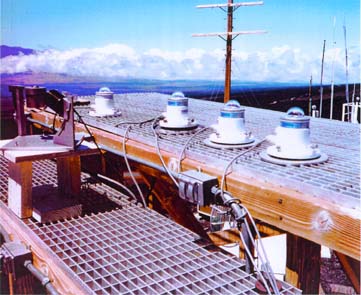

Broadband UV sensors are widely used for routine measurements of UV-B irradiance, particularly to estimate the erythemal response of the human skin, and to detect spatial and temporal changes in that quantity. Several commercial versions of the popular Robertson-Berger (RB) type of meter are available, and their spectral characteristics are generally somewhat similar to each other. The manufacturers of these instruments usually provide conversion factors for estimating various portions or weighted integrals of the UV spectrum, such as total UV-B (280-315 nm or 280-320 nm), Diffey Action Spectrum, Parrish Action Spectrum, or the DNA weighted spectrum. However, these estimates can be significantly in error because of the fact that the actual spectral response of the instrument can be significantly different than the portion of the spectrum being estimated, which in turn causes strong ozone dependence of the measurements. This occurs because of the strong variation of ozone absorption of UV in the UV-B region of the spectrum.
The principle of operation of the RB type of instrument depends on a UV-sensitive phosphor that absorbs radiation in the UV-B region and re-emits in the green region. Radiation from the whole sky passes through a quartz dome and is incident on a horizontal UV broadband filter that transmits the UV to the phosphor. The green light emitted by the phosphor passes through a green filter and is measured by a photodiode that has its peak response in the green part of the spectrum. The instruments used in these studies are Model UVB-1s obtained from Yankee Environmental Systems. The UVB-1 is temperature stabilized at 45°C.
The absolute calibration of RB-type meters, including detailed theoretical studies of these instruments, has been done by comparing broadband instruments with a spectroradiometer. Spectral data from the spectroradiometers were integrated using various weighting functions to approximate erythemal or other biological responses, and the results were compared with the broadband measurements. The response of a broadband instrument is strongly dependent on both solar zenith angle (SZA) and total ozone. SZA is important because of the cosine dependence of horizontal incidence type sensors, the distribution of total irradiance between direct and diffuse components, and to some extent the variation of these with wavelength. Their response depends on ozone because various instruments have different spectral responses. Thus, the advantage of using spectroradiometers to calibrate broadband instruments is that various spectral weighting functions can be used in processing the data to simulate the spectral responses of broadband instruments at various SZAs and ozone values.
Mauna Loa Observatory is located on the island of Hawaii (19.53°N, 155.58°W, 3.4 km) and is operated by GML. Clear mornings occur at MLO >50% of the time providing an excellent site for solar radiation measurements, and especially Langley plot calibrations. Relative atmospheric transmission in the visible (broadband) has been measured at MLO since 1958, and optical depth since 1982, yielding an excellent optical depth record. Because of the Dobson spectrophotometer ozone measurement record at MLO (1957 to present) and the annual ozone cycle (220-310 DU in this study), the opportunity exists to obtain well-calibrated UV spectroradiometer measurements, and to relate them to the ozone record.
A scanning UV spectroradiometer was installed at MLO in July 1995. This instrument was developed and operated by the National Institute for Water and Atmospheric Research (NIWA) at Lauder, New Zealand, and has been included in a number of spectroradiometer intercomparisons. These studies have shown that short-term variations of UV-B irradiance are inversely correlated with variations in total ozone. Other studies of the relationship between ozone and spectral UV measurements have been reported in the Antarctic peninsula, in Antarctica, and in southern Argentina.
The UV spectroradiometer uses a horizontally mounted diffuser designed to view the whole sky and minimize cosine error. The entrance slit to the spectrometer is located 4.5 cm below the diffuser. A shading disk can be mounted on the instrument in order to separate the diffuse and direct radiative components. Stepper-motor-driven gratings cover the spectral range of 290-450 nm with a band-pass of about 1 nm. A complete scan requires about 200 seconds. The spectroradiometer is programmed to begin measurements at dawn and perform scans at 5° SZA intervals throughout the day beginning and ending at 95°, except that during the middle of the day the system switches to a scan every 15 minutes.
Calibration of the spectroradiometer is performed on site using a standard 1000-W FEL lamp, with calibration traceable to the National Institute of Standards and Technology (NIST), at approximately 6-month intervals. A wavelength calibration using a mercury lamp, and a stability test using a 45-W lamp are performed weekly for quality control. The cosine response of the sensor has been characterized, and all data have been corrected for cosine errors. The spectroradiometer and its operation at MLO is also described on the Mauna Loa Spectral UV page.
A Yankee UVB-1 (SN950208) broadband instrument has been in operation at MLO since August 1995. This instrument is operated according to the instructions provided by the manufacturer, and all data are recorded as 1-minute mean voltages on a Campbell Scientific data acquisition system.